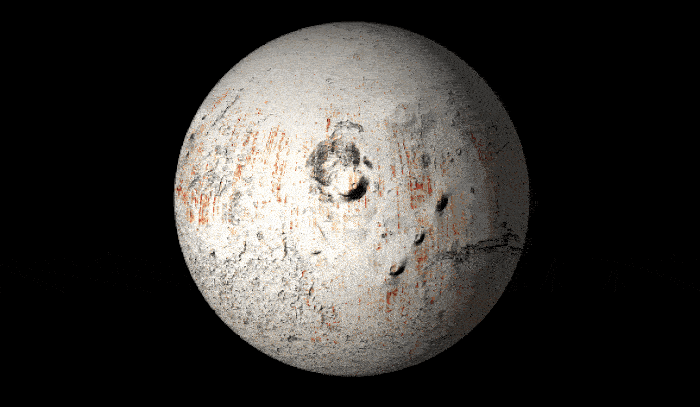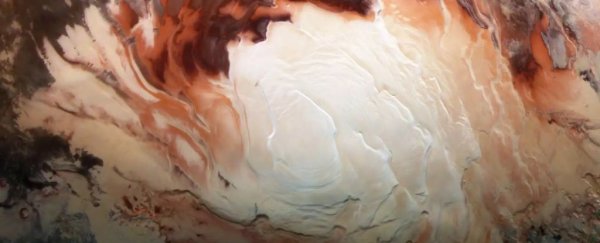The likelihood of lakes of liquid water hidden under Mars' southern polar ice cap is receding before our very eyes.
Last year, a paper found that temperatures were likely far too cold for water to remain unfrozen in the region. Now, a new study has found that the radar signal interpreted as liquid water was likely another resource Mars has in abundance: volcanic rock.
"Here, we aim to determine if Martian terrains today could produce strong basal echoes if they were covered by a planet-wide ice sheet," the researchers write in their paper.
"We find that some existing volcanic-related terrains could produce a very strong basal signal analog to what is observed at the South polar cap."
The detection of underground reservoirs of liquid water at the Martian south pole was announced in 2018.
Radar signals bounced from just below the planet's surface revealed a patch of something highly radar-reflective 1.4 kilometers (0.87 miles) under the ice, consistent with nothing so much as an underground pool of liquid water, the researchers said.
Subsequent searches turned up more shiny reflective patches, suggesting a whole network of underground lakes.
This would be huge. Here on Earth, underground bodies of water are places where we can find microbial life that relies on chemical reactions, rather than sunlight, to survive. If there's life on Mars, we might find it in a similar environment. But Mars is likely way, way too cold for such liquid reservoirs.
"For water to be sustained this close to the surface, you need both a very salty environment and a strong, locally generated heat source, but that doesn't match what we know of this region," says planetary scientist Cyril Grima of the University of Texas Institute for Geophysics.
This raises the question: Just what the heck are those shiny patches?
A subsequent paper examining the data found that frozen clay could produce similar reflectivity to the signal detected by the Mars Advanced Radar for Subsurface and Ionosphere Sounding (MARSIS) instrument on the European Space Agency's Mars Express probe.
Grima and his colleagues took a different approach. They laid a virtual ice sheet over the entire radar globe of Mars, comprising three years' of MARSIS data, showing what the red planet looks like through 1.4 kilometers (0.87 miles) of frozen water.
Then, they looked for reflective patches similar to those interpreted as water – and found them, scattered across all latitudes. Where they could, the researchers then mapped these patches against the known geology of Mars. The patches very neatly matched with volcanic terrain.
 (Cyril Grima)
(Cyril Grima)
Above: Mars as it might appear covered in ice. The red spots are volcanic/reflective patches.
Just as frozen clay is highly radar-reflective here on Earth, so too is volcanic rock that is rich in metal such as iron. We know that Mars has volcanic rock in abundance, and also an absolute whackload of iron.
Future remote-sensing missions could probe the ice cap to try and work out if this interpretation is likely – or, indeed, if frozen clay might be the culprit.
But the research offers new avenues for exploration, too. Namely, they can help us better understand the history of water on Mars.
"I think the beauty of Grima's finding is that while it knocks down the idea there might be liquid water under the planet's south pole today, it also gives us really precise places to go look for evidence of ancient lakes and riverbeds and test hypotheses about the wider drying out of Mars' climate over billions of years," says planetary scientist Ian Smith of York University in Canada, who led the frozen clay study.
The two scientists are now going to be working on mission proposals to use radar-based remote sensing to try and locate water on Mars, both pertaining to future crewed Mars missions, and to learn more about Mars itself.
"Science isn't foolproof on the first try," Smith says. "That's especially true in planetary science where we're looking at places no one's ever visited and relying on instruments that sense everything remotely."
The research has been published in Geophysical Research Letters.
